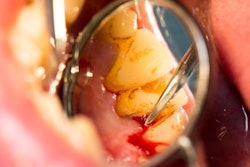
Dental practitioners in solo and small group practices don't widely use periodontal disease risk assessment tools even though they say they're open to using them, according to a new study. Researchers delved into the reasons why and provided recommendations for overcoming barriers to their use.
Researchers conducted focus groups with dentists and hygienists to learn about their thoughts on the use of risk assessment to predict periodontal disease occurrence. Practitioners were open to performing risk assessment as part of routine care, but they needed education on risk-based care, better ways to collect patient data, and validated risk assessment tools studied in real-world settings.
"To achieve this goal, it is essential to educate all dental providers and not just dentists on performing risk assessment and translating the results into actionable recommendations for patients," the authors wrote (BMC Oral Health, May 21, 2018).
They were led by Thankam Thyvalikakath, DMD, PhD, an associate professor and the director of the Dental Informatics Core Initiative at the Indiana University School of Dentistry in Indianapolis.
Appetite for assessment
Many patients apparently with good periodontal health have underlying factors that increase the likelihood of developing periodontal disease, the authors noted. The importance of periodontal disease risk assessment and preventive management is promoted by dental organizations and schools, and many risk assessment tools are available. However, solo and small group practices, where most people receive dental care, are not using these tools widely, according to research, and their use in these settings has not received much attention.
To learn more about the risk assessment needs of practitioners and to design better tools for improving patient care, researchers conducted six focus groups with 27 dentists and 25 hygienists in Pittsburgh and New York City.
A panel of two dentists, one hygienist, and two researchers wrote a script for the focus groups designed to explore issues related to the adoption of risk-based care for periodontal disease.
“It is essential to educate all dental providers and not just dentists on performing risk assessment.”
In the focus groups, practitioners most commonly said risk-based assessment meant identifying all possible risk factors and assessing the affect on a patient's oral health of a given risk. Most participants typically integrated risk assessment into their comprehensive exams, obtaining relevant information from various sources, such as a patient's medical history and clinical signs and symptoms found during oral examination.
Most practitioners recorded individual patient data, such as pocket depth and bleeding index, during the periodontal examination but relied primarily on professional expertise and experience to assess oral health and risk factors.
"In most cases, [dental practitioners] consider this intuitive evaluation sufficient but do admit that acquisition of this skill may require years of experience and learning," the authors wrote.
They added, therefore, that it is important to have objective and standardized methods for periodontal disease risk assessment.
Only a few participants said they performed a more systematic risk assessment using tools, such as the ADA's caries risk assessment form. However, practitioners were largely open to using risk assessment tools regularly.
"A major finding of this study is the dental providers' strong emphasis that a successful risk assessment tool would assist them in educating and changing their patient's behavior to adopt healthy lifestyle behaviors," the authors wrote.
Overall, the study participants believed that performing risk assessment could help practitioners with the following:
- Practicing preventive dentistry
- Playing a bigger role in patients' health
- Educating patients and dental students
- Increasing patient satisfaction
- Boosting the business of dental practices
At the same time, study participants identified barriers to performing risk assessment:
- Lack of scientific validation of risk assessment tools
- Underreimbursement of a time-consuming process
- High expense of implementation
- Resistance to changing practice routines
- Difficulty of changing patient habits
- Potential unintended consequences, such as reduced face time with patients while entering information into a computer or misuse of assessment results by insurance companies
Focus group participants pointed out factors that encourage providing risk-based care:
- Promoting risk assessment to all dental care stakeholders, including support staff, hygienists, dental assistants, dental students, and patients
- Adopting risk assessment universally as a standard of care, including endorsement by dental associations
- Providing monetary incentives to practitioners
- Availability of risk assessments tools that are well-designed, clinically based, and scientifically validated
"According to study participants, the research community has focused more on translating research findings into a risk assessment tool and less on how clinicians would use these tools during patient encounters and if it affects a patient's risk or outcome," the authors wrote.
The way forward
The study included practitioners from urban and suburban areas of two densely populated metropolitan areas, and their views may not reflect those of providers in other locations, such as rural areas. The results, therefore, may not be generalizable to all dental practitioners, the authors noted. To remedy this issue, they plan to survey dentists and hygienists in other areas of the U.S. on themes identified in the study.
The authors provided suggestions for wider incorporation of periodontal risk assessment in dental care, including the development of electronic tools for practitioners and patients.
"Recommendations to overcome major barriers included educating dental providers at all levels, conducting more research about their adoption and use in real-world settings, and developing appropriate reimbursement models," they concluded.


















